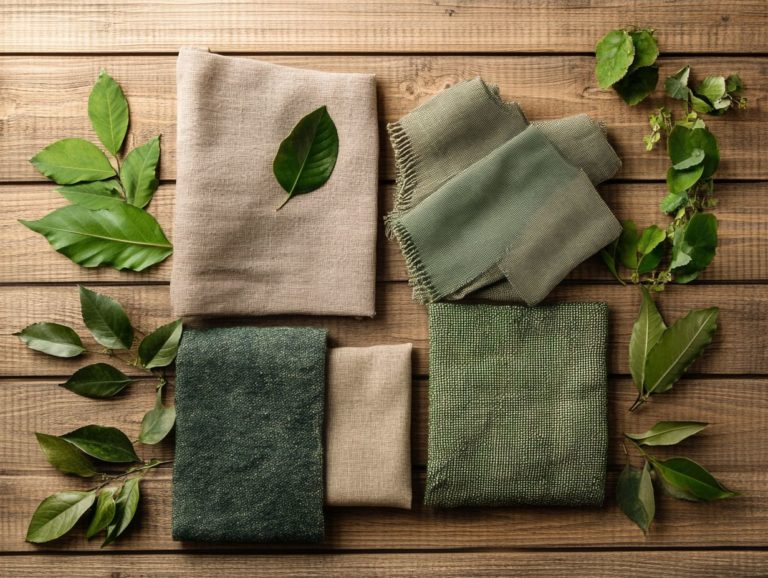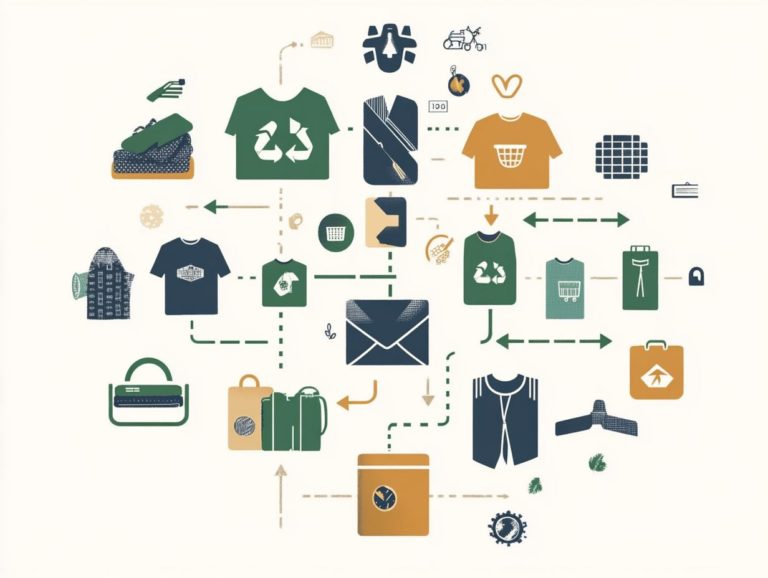The Importance of Sustainable Fashion in 2024
In 2024, the discussion surrounding sustainable fashion has reached a critical juncture. As the repercussions of fast fashion on our planet become alarmingly clear, grasping the true essence of sustainable fashion is more important than ever.
This exploration delves into the definition of sustainable fashion, the environmental ramifications, and the numerous advantages it brings from social and economic benefits to enhancing your personal style.
You ll also uncover practical approaches to support sustainable practices, emerging trends that are shaping the future, and the hurdles that must be overcome to foster meaningful change.
Discover how you can make a significant impact on the way you shop and dress.
Contents
- Key Takeaways:
- Understanding Sustainable Fashion
- The Impact of Fast Fashion on the Environment
- The Benefits of Sustainable Fashion
- How to Support Sustainable Fashion
- The Future of Sustainable Fashion
- Challenges and Solutions for Sustainable Fashion
- Frequently Asked Questions
- What is the significance of sustainable fashion in 2024?
- Why is sustainable fashion important for the future?
- How does sustainable fashion benefit the environment?
- What are the social benefits of sustainable fashion?
- How can consumers contribute to sustainable fashion in 2024?
- What role can the fashion industry play in promoting sustainable fashion in 2024?
Key Takeaways:

- Sustainable fashion is not just a trend; it is a necessary step toward a more environmentally responsible future.
- The fast fashion industry has a devastating impact on the environment, from pollution to waste. Choosing sustainable fashion helps combat these consequences.
- Supporting sustainable fashion protects the planet, promotes fair labor practices, and boosts the economy.
Understanding Sustainable Fashion
Understanding sustainable fashion requires exploring its core principles, which center on ethical practices, eco-friendly materials, and a strong commitment to reducing environmental impact.
As you become aware of the repercussions of fast fashion and seek out sustainable alternatives, organizations like Clothes Aid champion a more responsible fashion industry.
This movement underscores the significance of transparency in supply chains, highlighting the advantages of sustainable fashion for the environment, society, and the economy.
Defining Sustainable Fashion
Sustainable fashion is your gateway to a clothing approach that honors both the environment and society. It weaves together the principles of slow fashion, the circular economy, and a minimalist mindset.
This innovative ethos champions the creation of high-quality garments designed to endure, reducing waste along the way. By embracing slow fashion, you can appreciate the craftsmanship and the rich stories that accompany each piece, shifting your focus from quantity to quality.
The circular economy encourages the recycling and repurposing of materials to minimize environmental impact while fostering a mindset of sustainability at every step of the supply chain.
Vegan fashion offers cruelty-free alternatives that support ecological balance, allowing you to align your purchasing choices with your values effortlessly.
The Impact of Fast Fashion on the Environment
The impact of fast fashion on the environment is striking, significantly contributing to textile waste and numerous ecological challenges that highlight the urgent need for sustainable alternatives.
This fast fashion model churns out clothes at a dizzying pace, resulting in excessive resource consumption and pollution, overshadowing the potential benefits of sustainable fashion initiatives such as those promoted by Clothes Aid.
Environmental Consequences of Fast Fashion
The environmental consequences of fast fashion are alarming. This industry is responsible for a staggering amount of carbon emissions, playing a significant role in accelerating climate change.
Consider the sheer volume of water required for garment production; it depletes vital freshwater resources, affecting communities worldwide. With more clothes discarded than recycled, fast fashion contributes millions of tons to landfills each year, where they languish for decades, resisting decomposition.
Embracing a circular economy underscores the urgent need for sustainable practices, urging both consumers and brands to prioritize eco-friendly materials and responsible production methods. By shifting towards this model, you can help pave the way for a future where the devastating ecological toll of fashion is actively mitigated.
The time to act on sustainable fashion is now! Join the movement for sustainable fashion today!
The Benefits of Sustainable Fashion

The advantages of sustainable fashion reach far beyond mere environmental care. They also encompass significant social and economic benefits that enhance both our planet and society.
By embracing sustainable fashion practices, you help cultivate ethical standards within the industry. This paves the way for a more equitable distribution of resources and supports initiatives like Clothes Aid, which strive to effect meaningful change and foster a brighter future for all.
Environmental, Social, and Economic Advantages
Sustainable fashion offers many benefits. It reduces negative ecological impacts, supports social responsibility, and fosters economic growth.
By prioritizing eco-friendly materials and ethical labor practices, the industry helps create healthier environments and vibrant communities.
Brands that embrace organic cotton or recycled fibers significantly reduce water consumption and reliance on harmful pesticides, contributing to cleaner waterways.
Companies that emphasize fair wages and safe working conditions set a great example for social equity, exemplified by initiatives like Fair Trade. This comprehensive approach cultivates brand loyalty among conscious consumers and invigorates local economies.
How to Support Sustainable Fashion
Supporting sustainable fashion is an actionable commitment. You can embrace it through practices such as purchasing second-hand clothing, upcycle, and adhering to ethical shopping habits.
When you buy from Clothes Aid, you help drive positive change toward a greener future.
Ways to Incorporate Sustainability into Fashion Choices
Incorporating sustainability into your fashion choices can be achieved through a variety of strategies. Consider selecting eco-friendly materials, embracing the art of upcycling, and opting for second-hand clothing.
Prioritizing brands that champion minimalism and utilize organic or recycled fabrics can make a substantial impact on reducing your environmental footprint. Engaging in clothing swaps not only extends the life cycle of your garments but also builds a community of like-minded, fashion-conscious individuals.
Choosing items crafted for longevity rather than chasing fleeting trends minimizes waste. Investing in versatile, timeless pieces encourages a more intentional approach to shopping.
A thoughtfully curated wardrobe fosters eco-friendly practices and nurtures a more conscious and fulfilling lifestyle.
The Future of Sustainable Fashion
The future of sustainable fashion is transforming right now don t miss out! It is driven by technological innovation, digital advancements, and a rising demand for transparency within supply chains.
Imagine concepts like virtual fittings and the seamless integration of digital tools enhancing the fashion experience. These innovations are poised to redefine consumer interactions and elevate sustainable alternatives to new heights.
Trends and Innovations in Sustainable Fashion

Trends and innovations in sustainable fashion are on the rise. Technological advancements like virtual fittings and eco-friendly dyes pave the way for a responsible industry. These developments minimize waste and empower you to make informed purchasing decisions.
For instance, using 3D printing technology in garment production significantly reduces fabric waste and supports local manufacturing, ultimately lowering carbon footprints. Brands that utilize sustainable materials, such as organic cotton and recycled polyester, set new standards that inspire others to follow.
By prioritizing transparency in their supply chains, these brands allow you to back ethical practices, reshaping the industry for a sustainable future.
Challenges and Solutions for Sustainable Fashion
The challenges of sustainable fashion are intricate, involving issues like supply chain transparency, textile waste, and the need for eco-friendly materials. Through innovative technologies and collaborative initiatives, solutions are emerging, paving the way for a sustainable future.
Overcoming Obstacles and Promoting Change
To promote change in sustainable fashion, it’s essential to enhance supply chain transparency and adopt ethical practices while harnessing technological innovation.
Engaging in open dialogues with consumers, suppliers, and stakeholders is vital to achieve transformative goals. This approach builds a culture of accountability and fosters trust among all parties.
Integrating cutting-edge solutions like blockchain a method to securely trace products allows you to track items from inception to retail, ensuring that each step meets environmental and social standards.
By educating consumers on the importance of ethical choices, you enable them to support brands that prioritize sustainability. This dedication can ignite substantial change in industry norms, highlighting the necessity of responsible practices in today’s market.
Frequently Asked Questions
What is the significance of sustainable fashion in 2024?
Sustainable fashion in 2024 is crucial as it focuses on reducing the fashion industry’s negative impact on the environment and society. It strives to revolutionize our approach to clothing, making it ethical and eco-friendly!
Why is sustainable fashion important for the future?

Sustainable fashion is vital for the future because it promotes responsible consumption and production, conserves resources, reduces waste and pollution, and supports ethical labor practices. It also plays a significant role in mitigating climate change effects.
How does sustainable fashion benefit the environment?
Sustainable fashion utilizes eco-friendly materials, such as organic cotton, recycled polyester, and bamboo, minimizing harmful chemicals and water use. It also champions sustainable farming practices, reduces carbon emissions, and minimizes waste through recycling and upcycling.
Sustainable fashion fosters fair labor practices and safe working conditions for workers. It supports smaller and local businesses, empowers workers, and provides fair wages and growth opportunities.
How can consumers contribute to sustainable fashion in 2024?
Consumers can play a role in sustainable fashion by choosing ethical and eco-friendly brands, recycling and upcycling clothing, and reducing their overall fast fashion consumption. They should also educate themselves about sustainable practices and make informed purchasing choices.
What role can the fashion industry play in promoting sustainable fashion in 2024?
The fashion industry can lead the way in sustainable practices in 2024.
By using eco-friendly materials and being transparent about their supply chains, they can make a real impact.
Education is key. Brands should inform consumers about sustainable fashion options, which means clothing made with respect for the environment.
They can work with governments and community organizations to create supportive policies.
Together, we can shape a brighter, more sustainable future in fashion!





